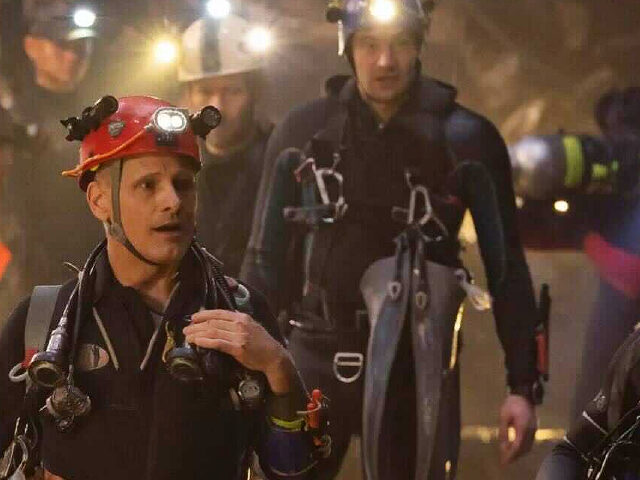Director Ron Howard’s Thirteen Lives is an informative but distant and uninvolving look at 2018’s miraculous Tham Luang cave rescue of 12 young soccer players and their adult coach.
In June of 2018, twelve boys aged 11 to 16 finished soccer practice and decided to explore a cave with their 25-year-old coach. Unfortunately, before they could get out, heavy rains hit Thailand, the cave was flooded, and all 13 were trapped.
Everyone knew where the boys were. Nevertheless, for nearly two weeks, no one knew if they were alive or dead because of all the water and flooding. Then two British divers, John Volanthen and Richard Stanton, found them after swimming for hours through 2.5 treacherous miles of cramped spaces, falling rock, brutal tides, and limited visibility.
Between July 8 and 10, four British divers (Volanthen, Stanton, Jason Mallinson, and Chris Jewell), two Australian divers (Richard Harris and Craig Challen), and one Irish diver (Jim Warny) brought all 13 safely out one by one.
Supporting the effort was a cast of thousands from Thailand and worldwide. This included Thailand’s Navy SEALS, the locals who understood the area and helped divert the water from flooding, and many more…
And that’s the movie’s problem.
Two of the best entertainment pieces of the last ten years are Zero Dark Thirty (2012) and Chernobyl (2019).
In Zero Dark Thirty, director Kathryn Bigelow and screenwriter Mark Boal take the viewer on a fascinating, engrossing, and suspenseful quest to find and kill Osama bin Laden. This is done through the eyes of our protagonist Maya (Jessica Chastain), a CIA analyst — who does not exist in real life.
In the HBO miniseries Chernobyl, an equally fascinating, engrossing, and suspenseful look at how the Soviets dealt with their 1986 nuclear disaster, we are led by three protagonists, including Emily Watson’s nuclear physicist Ulana Khomyuk — who does not exist in real life.
In both cases, as a means to tell the best and most accurate story possible, viewers are gifted with protagonists to carry us through the narrative, even though some events and some of these characters were fabricated.
Thirteen Lives (available on Amazon Prime) doesn’t do that. We have no protagonist. Instead, we have a sprawl of characters, none of whom we get to know very well. The result is a well-filmed, informative, uninvolving, and episodic tick-tock of an extraordinary event.
That doesn’t mean Howard’s near misfire is without heart. You can’t help but be moved watching a province and then a country, and then the world come together with the shared goal of saving human life. What’s more, some of the diving scenes, especially the early ones, are harrowing to sit through, thanks primarily to the excellent sound design of men breathing and oxygen tanks scraping against rock. Unfortunately, these scenes feel a bit repetitive when we reach the main rescue.
Another problem is the lack of an antagonist. Certainly, the weather and the situation itself get in the way, but once the boys are found, the tension lessens, especially when the weather cooperates.
Some reviewers have either accused or applauded Howard for avoiding the “white savior” problem — of going woke at the expense of his art. In other words, rather than focus on the British and Australian guys who did the most dangerous work and came up with and executed the audacious plan that saved the day, Howard treats every contribution, including the water diversion, equally. That would certainly explain Howard’s approach, but why not focus on the embattled Narongsak Osatanakorn, the outgoing governor of the province, the man who had to make every tough call, who was being set up as the nation’s fall guy should things go sideways?
The actors, especially Colin Farrell, Viggo Mortensen, Joel Edgerton, and Sahajak Boonthanakit (as the put-upon governor), do what they can to establish their characters. The filmmaking is certainly competent. But at nearly 150 minutes, the movie feels long, even though it shouldn’t.
What’s missing is the kind of dramatic license that creates compelling characters we root for and want to succeed. The hunt for Osama bin Laden and the near-miss of a worldwide nuclear disaster at Chernobyl would both make for fascinating documentaries. But what makes Zero Dark Thirty and Chernobyl rewatchable and compelling are the characters and their relationships.
Regardless of the event, no storyteller will ever come across anything more fascinating than the human condition than watching people operate under intense pressure. You’d think Ron Howard would have learned that with his classic, Apollo 13 (1995).
Follow John Nolte on Twitter @NolteNC. Follow his Facebook Page here.

COMMENTS
Please let us know if you're having issues with commenting.